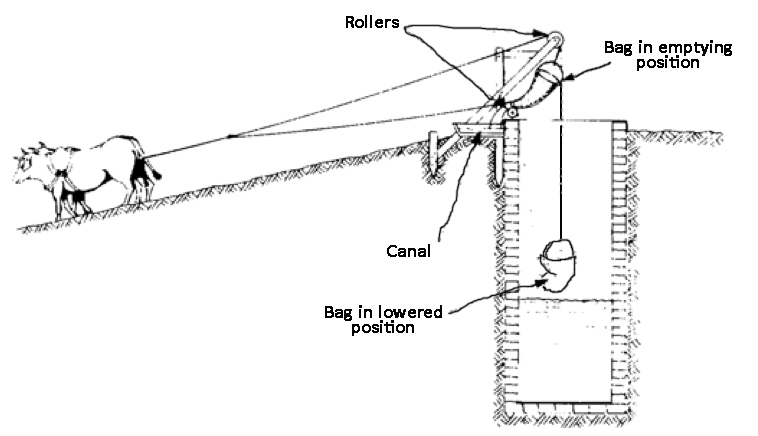Bucket hoists, Windlasses, and Mohtes
| |
|
|
|
|
|
|
|
|


The bucket hoist, windlass, and mohtes (charsa or charus) are all modifications of the simple Rope and bucket system, to improve ease and efficiency.
There is a family of devices for pulling up a container of water on a rope. The simplest form for this is a rope and bucket, which in an improved form has a simple windlass, i.e. a hand operated winch, to increase the leverage and hence the size of bucket that can be lifted.
The output of such systems is generally too small for irrigation, (they tend to be used mainly for domestic or livestock water supply duties), but by powering the device with animals, usually oxen, sufficient water can be lifted to irrigate even through heads of 5-10m.
The two-bucket alternative
The rope and bucket lifter can also be adapted to include two buckets which are raised and lowered alternately. In this case the pulling animal moves in a circular path and with the help of central rotating lever, rope and pulley arrangement the buckets move up and down. Each bucket has a carrying capacity of up to 70 litres. The buckets have a hinged flap at the bottom, which acts as a valve. Guide rods are provided in the well to control the movement of the buckets. The buckets are automatically filled and emptied during operation. This device can lift about 230 litres /min from depths of up to 5 metres.
Mohte
Soon came the evolution of the "self-emptying bucket", known in India as a "mohte". This commonly has a bucket made of leather, galvanized iron sheets, or rubber, and with a hole in its bottom which is held closed by a flap which is pulled tight by a second rope harnessed to the animals. The device consists of a bucket having a capacity of 180 -225 litres. The bucket is fixed on a stout iron ring with an iron framework at the top. It is attached to one end of a long strong rope. A pair of bullocks (castrated bulls) are hitched to the other end of the rope which provide the power to lift the bucket. The bullocks, while pulling up the full bucket, walk down an earthen ramp sloped at an angle of 5 -10 degrees, thereby obtaining some advantage of their weight in exerting the necessary force to lift the bucket. Two men are needed to operate one pair of bullocks. Two buckets at a time can also be operated with one extra pair of bullocks. It is suitable to lift water from deep wells. The depth may exceed even 30 metres. Two pairs of bullocks with three men discharge about 9000 litres of water per hour from a depth of 15 metres.
Suitable conditions
The number of mohtes in use today is still in the order of a million or more, so this device remains of considerable importance in some regions.
| Advantages | Disadvantages |
|---|---|
| - Simple technology which is inexpensive to build and maintain. - Can be operated at depths of up to 100 m. |
- Water Delivery from Human Operated Rope and Bucket Water Lifter is limited to 15 l/min. - Animals need to be maintained all year even when irrigation is not necessary. |
Acknowledgements
- REVIEW OF PUMPS AND WATER LIFTING TECHNIQUES. Natural Resources Management and Environment Department, Food and Agriculture Organization (FAO).
- Water Lifting Devices, Booklet No. 262. Irrigation: IRS - 1. Inseda.org
- Jane Olley, Human and animal powered water lifting devices. Practical Action. November 2008.

